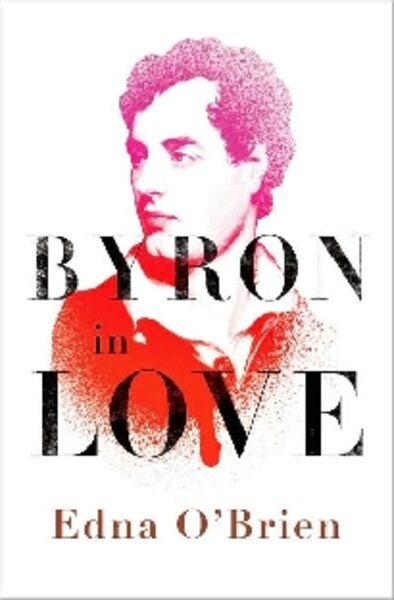Byron in Love
Loading...
Perhaps it’s a cost-cutting measure: Save on ink by cutting back on commas (even in the subtitle) and omitting semi-colons altogether. Or maybe it’s more insidious: Save money by cutting copy editors. Whatever the explanation, here’s fair warning that reading Edna O’Brien’s Byron in Love: A Short Daring Life is at times – for want of editing – more challenging to parse than the passionate, iconoclastic 19th-century poet’s verse.
The disappointment is acute, for O’Brien, a passionate, iconoclastic writer herself – her early, sexually frank “Country Girls” novels were banned and burned in her native Ireland when they first appeared in the 1960s – is well suited to her subject. She has pored over reams of Byron’s letters and journals and digested Leslie A. Marchand’s 1957 three-volume “Life of Byron” to present a vivid portrait of the man whom Lady Caroline Lamb, one of his scores of jilted lovers, called “Mad, bad, and dangerous to know.”
As captured by O’Brien, Byron was at once brilliant, magnetic, and monstrous – an arrogant son; an insatiable seducer of both sexes; an incestuous adulterer; a spendthrift; a wildly original, popular, and vilified poet; a cruel and neglectful father; a passionate traveler; and a generous friend. He idolized Napoleon and loved Greece.
O’Brien notes, “The word Byronic, to this day, connotes excess, diabological deeds and a rebelliousness answering neither to king nor commoner. Byron, more than any other poet, has come to personify the poet as rebel, imaginative and lawless.”
George Gordon Byron was born in London in 1788 to a 22-year-old Scottish woman descended from King James I and violent Scottish feudal barons. By the time Byron was born, Catherine’s vagrant husband, “Mad Jack” Byron, had run through her money and fled to France to avoid imprisonment for debt.
Byron’s delicate-featured beauty was marred by a malformed right calf and clubfoot, one of many woes he blamed on his mother. His philandering father died of consumption before his fourth birthday, leaving mother and son to an itinerant existence at the mercy of lawyers and relatives. “Mad Jack” also left a daughter, Augusta, from an earlier marriage – the half sister who was to become what was arguably the greatest love of Byron’s life.
After the 1798 death of his grand-uncle, known as the Wicked Lord, Byron at 10 became the sixth Lord Byron and inherited the derelict 12th-century Gothic family seat at Newstead. Among the people he lorded over was his unprepossessing mother. O’Brien writes: “His demands on her were not that of a son but of a tyrannical husband.”
In keeping with his new status, he attended boarding school at Harrow, followed by Trinity College, Cambridge, where he developed a forbidden passion for a 15-year-old choirboy – “the love he could not live without and yet could not live with, as suspected sodomites were imprisoned.” He fled to London and then abroad, without a degree but with several lifelong friends.
Byron was forever in debt, for he was “determined to live like a potentate,” necessitating continuous borrowing from moneylenders. Exacerbating his precarious finances, he generously deeded all income from his most successful publications – including “Childe Harold” – to his editor and publisher.
Although she touches on Byron’s poetry, O’Brien’s focus, as her title suggests, is his amatory life. She does yeoman’s work sorting through the tangled web Byron wove. What emerges is an ardent epistolary lover, more romantic on the page than in person. His habit was to flee from one bad affair into another – as when he attempted to outrun his passion for his married half sister by foolishly wedding righteous Annabella Milbanke, who later sought vengeance for his cruelty.
He tormented and ruined many women, behaving especially badly to Claire Clairmont, Mary Shelley’s stepsister, when he insisted on full custody of their daughter, only to abandon the child to a convent in Italy, where she died at 5. When the going got truly rough – as it did in 1816, he fled England. His last eight years were spent abroad, including several in Italy before launching a military mission to save Greece from the Turks. He died of a fever in war-torn Greece in 1824, rejected by the young boy he craved, and already past his prime at 36.
Unfortunately, Byron’s memoirs were burned by friends overeager to protect his legacy. As O’Brien’s rich but evenhanded portrait shows, the truth will surface anyway – even through egregious grammar. Byron’s best legacy, of course, is his romantic poetry, including these lines on unrequited love, from his last poem:
Thus much and more; and yet thou lov’st me not,
And never wilt! Love dwells not in our will.
Nor can I blame thee, though it be my lot
To strongly, wrongly, vainly love thee still.
Heller McAlpin, a freelance critic in New York, is a frequent Monitor contributor.






